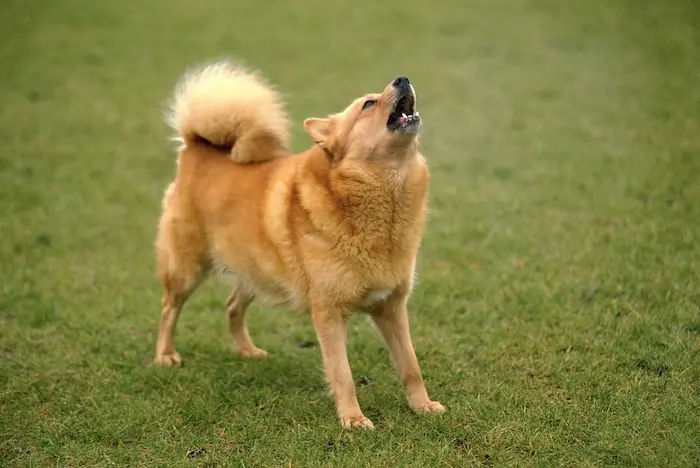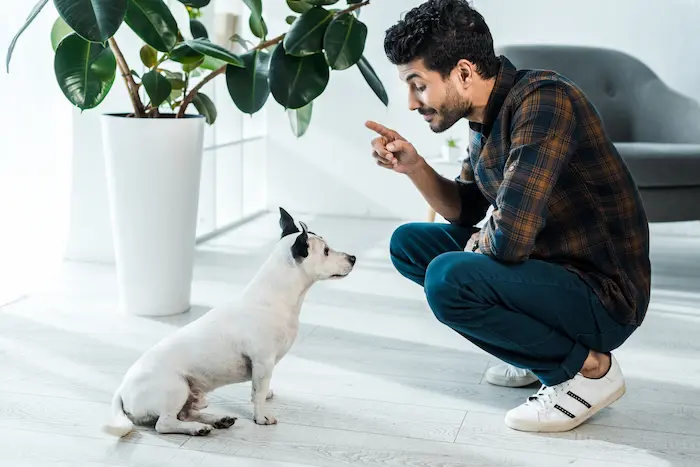
Dog barking is a primary form of communication and a natural reaction. However, when a dog barks excessively, it can be frustrating for many dog owners. Understanding why dogs communicate this way, giving them plenty of physical and mental exercise and providing focused training sessions are the keys to stopping your pet from barking excessively.
In this article, you’ll learn everything you need to know about barking dogs. By the end, you’ll be armed with a wealth of knowledge and training techniques to ensure your dog stops barking incessantly.
Why Do Dogs Bark?
Most dogs use barking as a way of expressing fear, distress or excitement, making a territorial claim or communicating with other dogs. To curb compulsive barking, it’s crucial you understand the general reasons dogs bark and pay attention to the individual events surrounding the barking behavior. It’s completely normal if your dog starts barking in certain situations. For example, it might want to alert you to a potential threat (a delivery person is an intruder to your dog), express anxiety, or a tired dog might bark at other dogs. If the barking has a natural cause and isn’t prolonged, you likely don’t have anything to worry about.
What’s more, pet owners should know that certain breeds bark more than other dogs. For instance, if you have a shepherd breed or a terrier, remember that it’s genetically inclined to guard and protect, so barking is part of its duty to you. This type of dog can’t be trained to stop barking completely. However, by setting clear expectations, being consistent and communicating effectively with your dog, it’s possible to stop it barking too much. With a few new tricks, simple commands and consistent training, you can let your dog know when it’s time to be quiet.
In cases when barking isn’t related to genetics, issues such as separation anxiety, being left alone for long periods, boredom, frustration, medical issues and attention-seeking could be reasons. Getting to the root cause of your dog’s barking is vital for finding the right training technique.
Differentiating Between Necessary and Unnecessary Dog Barks
Many dog parents misinterpret their dog’s behavior, thinking it’s being naughty when it’s just doing something that comes naturally. Barking is a dog’s way of communicating and trying to stop it entirely would be unkind and frustrating for you and your pet. That said, setting boundaries and teaching manners is essential for a happy pet-person relationship, and you should absolutely teach your dog not to bark unnecessarily.
For many dogs, unwanted barking happens because a pet parent has accidentally reinforced the behavior or didn’t train their furry friend to calm down on command. This type of unnecessary dog barking is easy to fix with positive reinforcement, obedience training, treats, toys and long daily walks.
Not all dogs bark excessively for a clear purpose, and this is more concerning, often requiring professional guidance. If a dog barks for no apparent reason, it could be indicative of a health issue or anxiety around a certain trigger. Either way, it’s vital you find out why before you can help them stop barking inappropriately.
Top 5 Methods on How to Train a Dog to Stop Barking
There’s no simple solution for most dogs, and stopping excessive barking requires a multipronged approach. Keep in mind that you should begin training sessions in the house, then move to your backyard and, finally, outside of your dog’s territory. It’ll be relatively easy to get your dog to stay quiet at home, but what about when it wants to bark at the cats next door when you set out for a walk? The secret is teaching obedience and ensuring your dog understands what commands mean.
Having your pet understand what you expect from it is a huge help when you want it to stop barking. Using the methods below, you can build a strong, trusting bond so it understands you and follows your commands.
1. Give Positive Reinforcement
Positive reinforcement is one of your most powerful tools when training your dog to stop barking. Whether your dog is mostly driven by a treat, praise or cuddles, you can use the things it loves to help you model the behavior you want. Put simply, when your dog stays calm and quiet in a situation that would make it bark, reward the behavior. Pet owners should know that yelling or yanking on a leash isn’t an effective way to communicate that you don’t want to hear a dog bark.
2. Divert Attention
When your dog barks, aim to divert its attention so it gets out of the habit of barking excessively at triggers. It’s super-important that you don’t reward barking behavior by giving it a treat or toy while it’s vocalizing. Instead, hold up a favorite treat or toy and let your dog know it can get the reward if it stops barking using an obedience command such as “quiet” or “enough.” Only offer positive reinforcement if it stops barking. Put the reward away, firmly say “no,” and turn your back if the barking continues. Repeat this process as many times as it takes for your dog to understand.
3. Use Halo Collar’s GPS Dog Fence for Boundary Training
Halo Collar’s GPS Dog Fence is a cutting-edge solution for excessive barking, especially when it’s related to territorial behavior. It combines boundary training with GPS tracking to create customizable virtual boundaries for your dog. Here’s how it helps:
- Clear boundaries. Halo Collar lets you create precise boundaries around your yard, giving you peace of mind that your dog can roam freely — and clearly setting a boundary so your dog knows its territory.
- Real-time feedback. Vibrations, sounds and static correction help your dog understand when it crosses boundaries in real time. Having this feedback mechanism in place helps your pet understand the limits of its territory, which can significantly reduce excessive territorial barking.
- Safety and freedom. Dogs thrive when they have the perfect balance of safety and freedom, with a clear human leader and properly defined territorial boundaries. When it can enjoy outdoor activities and knows when to respect established limits, your pet is more likely to be calm and content.
4. Train With Obedience Commands
When training your dog to stop barking, choose one command, stick with it, and teach it to everyone in the household for consistency. “Quiet,” “Enough,” and “Stop” are effective options that specifically address barking. When training, teach one word at a time and take as long as your dog needs to learn what the command means. Eye contact is another crucial element of obedience training, and having a “look at me” command to use first might be necessary for very reactive dogs.
5. Offer Lots of Physical and Mental Exercise
Physical and mental stimulation are crucial for your dog’s happiness and health. One of the best ways to help a loud and excitable dog calm down is by giving it as much to do as possible. Puzzle toys and games are great for the indoors. Daily training sessions help you and your pet bond while providing mental and physical stimulation — and, of course, walks.

Stopping Your Dog’s Barking: The Importance of Patience and Consistency
Every dog moves at a different pace, so be patient and pay close attention to what works best for your unique pet. Some dogs are more food-motivated, while others prefer toys or affection. Whichever training method your dog responds to best, it’ll only be effective if you’re consistent.
Dogs thrive on routine and predictability and love understanding what you expect from them. Just like people, mixed signals are confusing for dogs — but they don’t have the capacity to understand complex language. So, if you ignore barking sometimes but tell it not to at others, your dog isn’t going to understand your command. Provided you’re patient and consistent, you’ll be able to keep your dog’s barking in check.
Seeking Professional Help — When and Why
Seeking professional help from a dog trainer like Cesar Millan is advised for persistent or complex behavior issues. His methods, based on a deep understanding of canine psychology and decades of experience, earned him the title of Dog Whisperer. By intentionally building the right kind of relationship between you and your dog, you can get the best out of training — but this often requires expert guidance. If your dog is barking and causing problems at home, don’t hesitate to speak to a professional.
Take the Lead and Curb Excessive Barking Today!
When it comes to training your dog, establishing boundaries is paramount. And it’s not just about mental boundaries and commands to help your dog learn what’s expected from it. A Halo Collar GPS Dog Fence helps your dog understand precisely which territory it’s protecting, limiting unwanted barking and promoting obedience.






